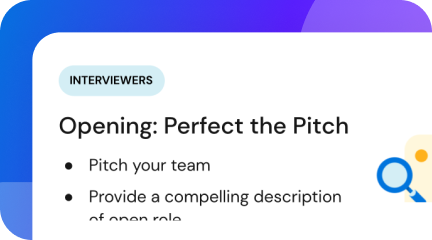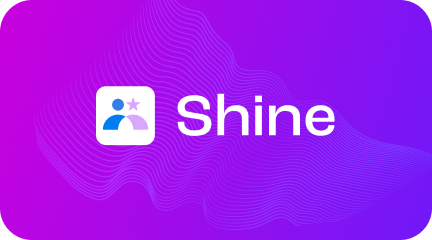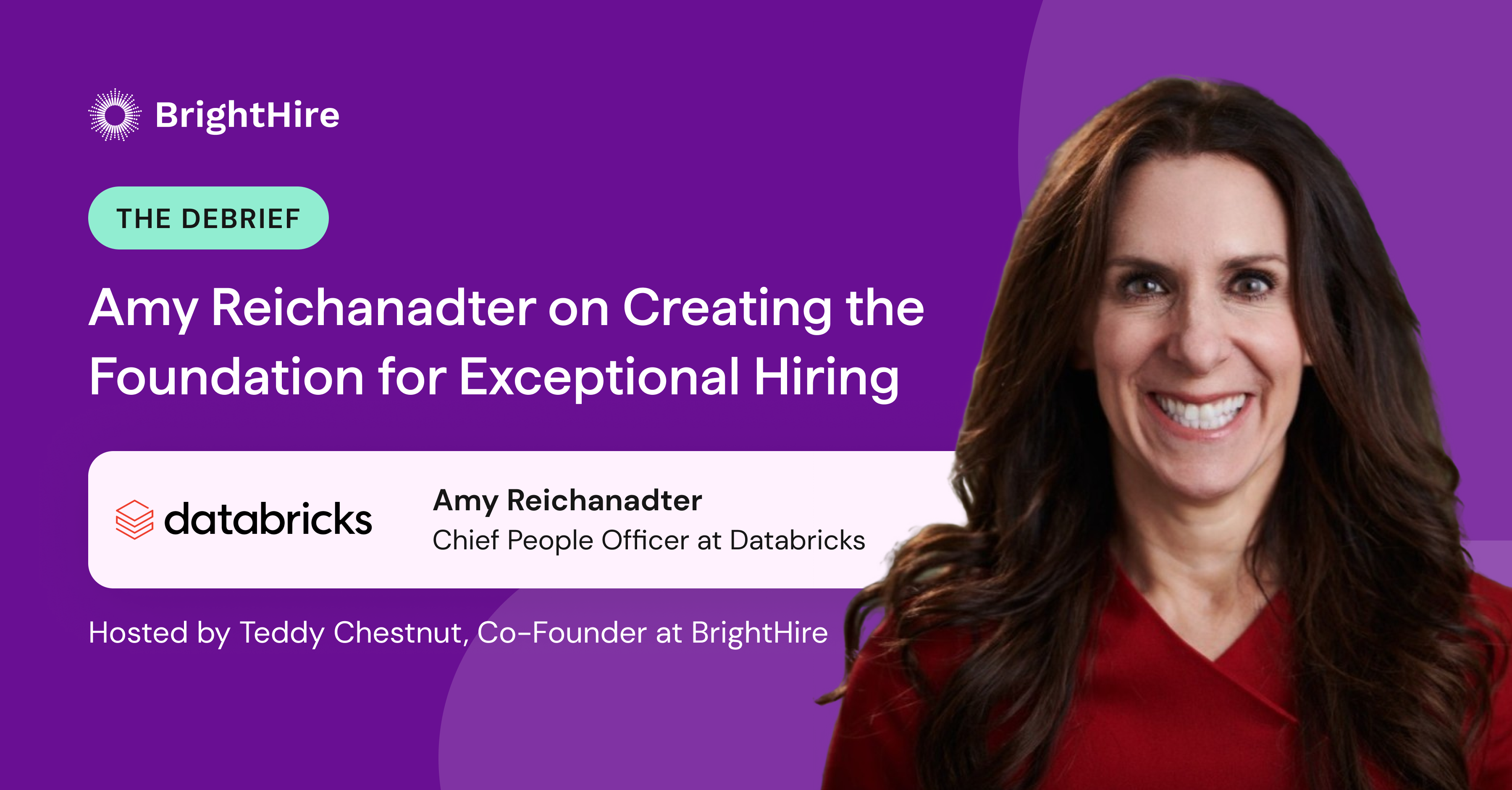Imagine this: You’ve just finished interviewing one of the candidates for an open position on your team. It might be tempting to step away after the interview and “sleep on it,” letting your thoughts percolate in your brain for a while before writing anything down. Resist that temptation, though — the longer you wait to write down your notes, the more likely you will forget things. That’s especially true if you’re interviewing multiple candidates at once.
Instead, organize your notes when the interview ends and debrief with your colleagues as soon as possible. Whether this debrief happens in a meeting or asynchronously via emails, chats, or shared documents, it should happen right after all interviews are completed. This gives each stakeholder a chance to share their thoughts while they’re fresh, minimizing the chances that they’ll forget things or become biased by other factors.
If your team chooses to have a synchronous debrief meeting, we’re here to help you conduct the most productive and equitable version of that meeting possible.
Let’s discuss how to run an effective interview debrief, manage disagreements, and make the best hiring decisions for your company.
What is an interview debrief?
An interview debrief is a meeting of the hiring team — hiring manager, recruiter, and other interviewers and stakeholders — to discuss each candidate and make informed decisions together.
Now more than ever, hiring has become a very important part of a company’s success. It used to be a more cyclical process that focused on “putting butts in seats,” but now many businesses have come to realize that it’s vital for their revenue to get hiring right the first time around. It’s not just about hiring people to do the job — it’s about hiring the right people to do the job.
Many companies have implemented skills-based hiring practices to ensure that the candidates receiving offers are the ones who most excel at the competencies required for the position.
This method emphasizes the importance of identifying specific skills required for a role and evaluating candidates based on their proficiency in those areas. By shifting the focus to tangible skills, organizations can promote more equitable hiring practices, improve the quality of their hires, and ensure that the most qualified individuals, regardless of background, are selected.
When practicing skills-based hiring during a candidate debrief, it helps to organize your notes based on the competencies required for the position, and to encourage your colleagues to do the same. This way, you are comparing candidates and interview notes apples-to-apples and can ensure a more calculated and consistent debrief.
Effective interview debriefs can help squash miscommunication amongst hiring teams and drastically improve quality of hire. It doesn’t matter how long the debrief is or whether it’s synchronous or asynchronous; as long as your team takes good notes, dedicates the time it needs for the debrief, and uses key competencies to help guide the conversation, it should be successful.
How to run an effective interview debrief
It’s almost guaranteed that team members will have unique and differing perspectives during the interview debrief. Below are some tips to help you run the most effective debrief possible — even when not everyone agrees.
1. Make sure your team is prepared before you start
Make sure all participants have recorded notes and scores for every candidate they interviewed. If you have access to interview recordings — or even better, an interview intelligence platform — ask team members to review the highlights of conversations they were not part of prior to the debrief.
2. Follow the recruiter
The recruiter or hiring manager who oversaw the interview process should lead and moderate the conversation, and other colleagues should defer to their leadership. The recruiter is responsible for keeping track of time and making sure all teammates are heard equally. It may be helpful for the recruiter to review interview clips or existing notes to help guide the conversation
3. Maintain a structured discussion flow
A structured discussion leaves less room for bias and creates more equitable opportunities for everyone to contribute their opinions. We recommend the following structure:
Step 1: Introduce the discussion.
Explain the purpose of the debrief and provide an overview of the process. Establish any necessary ground rules — for example, not interrupting another colleague during a speaking session, and respecting each other’s opinions.
Step 2: Review the candidates.
Follow a structured order when reviewing each candidate. Announce the candidate to be discussed, and ask each teammate who participated in (or reviewed the highlights of) an interview with them to give their scores and commentary for each of the core competencies you’re hiring for. Share all scores and general comments in succession and in order of seniority — least senior to most senior, to avoid bias based on deference — before opening the floor to conversation and debate.
For each core competency, probe major discrepancies. Explore why there are differences of opinion and invite commentary to compare them. If you have an interview intelligence platform, you may want to refer to the tapes or summaries at this time. If you need to lead the floor with specific questions, consider some of these to get the conversation started:
- What did you like most about this candidate?
- Did this candidate possess the core competencies we’re seeking for the role?
- Is there anything you’re worried about with this candidate that would prevent them from moving forward?
- Does this candidate align with our company values?
Step 3: Review the candidate pool altogether.
Once all candidates have been discussed, examine their aggregate scores. You can compare candidates easily using an editable scorecard like this one. Allow additional time to discuss candidates who performed similarly. You can also use the additional time for teammates to offer any last-minute commentary. Plus, don’t forget you can go back to your interview intelligence tool to rewatch any interview highlights to refresh your memory. With this, you can rely on the candidate’s actual words in the interview to make a decision, instead of your notes or memory.
Step 4: Make a decision.
This doesn’t necessarily have to be a final decision on who to hire for the position, but at the end of the debrief, you should be able to walk away with actionable next steps for the candidates discussed.
How to manage disagreements
An unavoidable part of the decision-making process is knowing how to disagree respectfully with your teammates. If there are conflicting opinions on the hiring team and no consensus on who to hire for the position, there are a few different ways you can manage these disagreements during the interview debrief.
Empower hiring managers to own the decision
While recruiters typically drive the interview debrief conversation, hiring managers drive the final decision on which candidate to hire. Sometimes hiring can spin into a purely democratic process where everyone must give a thumbs up to the best candidate — but that’s simply not always realistic. Know it’s okay to disagree and share concerns, but it’s ultimately up to the hiring manager to make the decision on who they want to manage and bring to the team.
Program disagreements into your scoring system
Sometimes, it’s best to get ahead of disagreements before they occur. As a part of your scorecard system, you could make it so that a candidate must score above a certain threshold from each of the interviewers and stakeholders to be discussed in the debrief and eligible to move forward. By doing this, you can secure agreement with everyone before the debrief happens, effectively eliminating any disputes.
Set expectations upfront
Before your team makes a decision — possibly before the interview process even begins — make sure to set expectations correctly. Ensure everyone on the team knows that no matter whether they were thumbs up, thumbs down, or on the fence for the chosen candidate, the team should come together to support the new teammate and set them up for success when they onboard. If someone isn’t entirely sold on the candidate and they let that show when that person joins, it can affect the team as a whole — no matter how perfect that new hire is for the role.
Compare candidates in their own words
It’s useful to compare your notes from one candidate to the next, but it’s something else entirely to compare candidates’ actual answers to interview questions. With BrightHire, you can access interview recordings after the interview is over and highlight specific clips or answers to review later. This makes it that much easier to directly compare one candidate’s answer to another’s, helping you and your team make the most informed decision possible.
Making great hiring decisions
Recruiters, TA teams, and hiring managers need to work in lockstep to make the right hiring decisions. Amazing work happens when there’s a true partnership between all interview stakeholders.
The easiest way to build a good partnership is trust, which means being able to back your skills-based interview answers with direct evidence from the interviews. Nobody makes this easier than BrightHire with their end-to-end interview intelligence platform 100% focused on hiring for the skills that matter.
Nail your next hire with our interview debrief template
Interviewing candidates and sharing your thoughts with your team doesn’t have to be difficult or time-consuming. With some work on the front end before the interview process begins — and team alignment around which skills are critical for the role — interview debriefs will become second nature.
Download our Productive Interview Debriefs Template to get started on running your own successful debriefs today.









